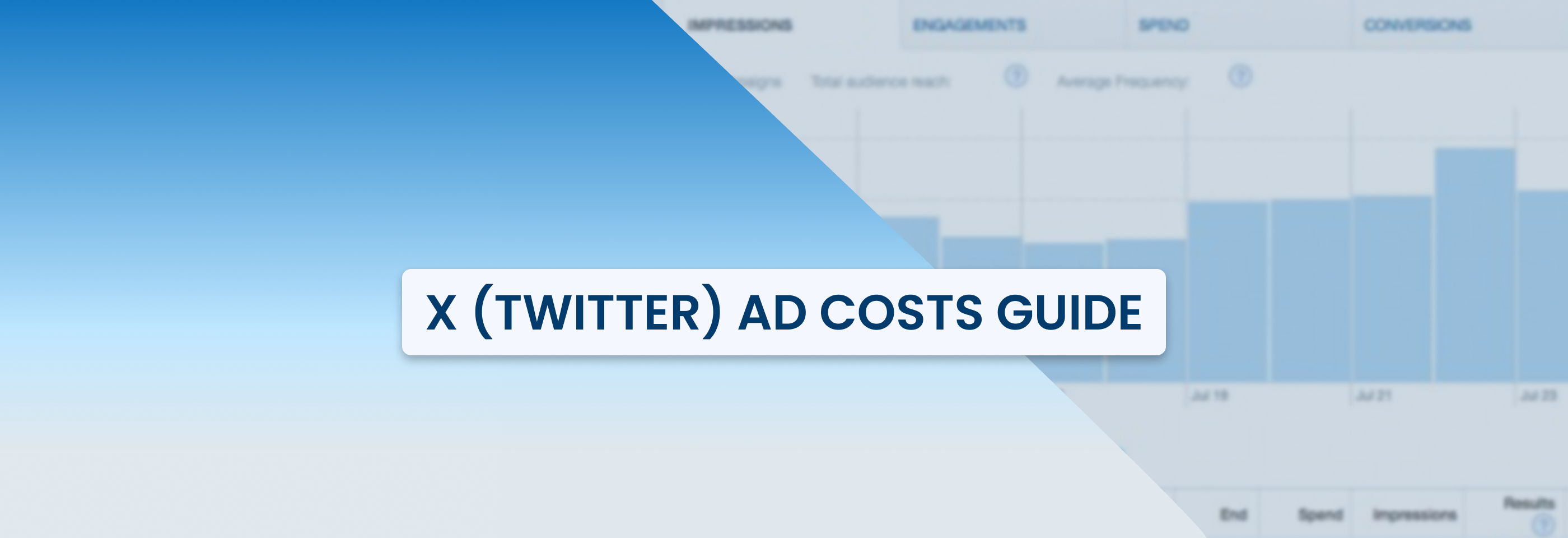How to Simplify Lead Generation with Facebook Lead Ads
2024-07-07

If you're trying to find new customers, you know how important it is to get leads. Leads are people who might be interested in what you offer, and turning them into real customers is key to growing your business. For advertisers, getting a steady stream of leads means more chances to make sales and build strong customer relationships.
That’s where Facebook ads come in: the platform’s huge audience and smart targeting options help you reach the right people at the right time, making it easier to turn their interest into action.
In this article, we’ll talk about lead generation as an integral part of the conversion funnel and Facebook ads as a great way to get high-quality leads, and explore the best practices for doing so.
What does lead generation mean?
First things first, let’s talk about the definition of lead generation.
Lead generation is the process of attracting and converting strangers into prospects who are interested in your business, which are called leads.
This is a key part of the conversion funnel, helping turn interested people into actual customers. Here's how it fits in:
- Awareness: at the top of the funnel, lead generation helps people learn about your business. With targeted ads, content, and social media, you attract people who might not have heard of your business before;
- Interest: once they know about you, lead generation keeps their curiosity going. Engaging content and valuable offers give them reasons to learn more about what you do;
- Consideration: now, they're actually considering your products or services. Offering detailed info, free trials, or consultations can help them consider you as a good option;
- Intent: at this point, they’re almost ready to buy. Personalized follow-ups, targeted offers, and testimonials can help them decide to go with you;
- Evaluation: here, they’re comparing you with competitors. Clear and compelling information about your benefits and unique features can help them choose you over others;
- Purchase: finally, lead generation helps turn interested people into paying customers. Persuasive calls-to-action, special discounts, and easy buying processes make it simple for them to buy from you.
By effectively generating and nurturing leads through these stages, you keep a steady flow of potential customers who are more likely to make a purchase.
Here are some popular lead generation strategies:
- Content marketing: you can create valuable content like blog posts, video demos, tips, and ebooks to attract potential leads;
- Email marketing: you can use email campaigns to connect with potential leads by sending newsletters, promotions, or helpful content;
- Social media marketing: you can post interesting content, run ads, and interact with followers on social media to drive traffic to your lead forms;
- Paid ads: you can run online ads targeting specific audiences to drive traffic to your lead forms.
As you can see, some of these strategies are organic (like content or social media marketing) and some of them are paid (like advertising). Both paid and organic strategies have their weaknesses and strengths, so it’s best to combine them for better results.
No matter which method you’re using, the end result you’re working for will be the same: users provide you with their contact information, like their email address or phone number, and become your leads in exchange for something valuable, i.e. the lead magnet.
What is a lead magnet? A lead magnet is a free offer, the sole purpose of which is to convince people to submit their information to you. This can be a discount, free advice or consultation, ebook, webinar, etc. – basically, anything that your potential leads can be interested in receiving.
Usually, most of these lead generation strategies include users filling out a form on your business’ website that they go to after seeing your ad, email, post, or something else. This takes some time and commitment because these users are ready to accept the interruption of what they were doing and proceed to your landing page, which potentially means that the leads you’ll get will be of a higher quality.
But the thing is, this won’t work in all cases. If people haven’t heard about your business or aren’t particularly interested in your offers yet, they won’t be likely to go and fill out your form since there aren’t enough incentives for them to do so.
That’s where Facebook ads enter the process: they allow users to fill out lead generation forms without leaving the platform, minimizing the obstacles on their way to becoming your leads. Let's talk about them in more detail.
Lead generation on Facebook
Facebook Lead ads make it easier for you to collect customer information without sending them to another website. When users see your lead gen ads in their feeds, they can fill out a form right in the app.
This is especially convenient since people don’t have to leave Facebook and the lead form will already include some of their information. They just need to complete a few more fields, submit, and get what they’ve been promised.
This makes lead generation on Facebook a great strategy for many businesses. Here's why:
- It’s easy for users: everything works quick and simple with Facebook Lead ads in comparison with other lead generation methods. People don’t have to go to another website to fill out a form, which can be annoying and cause drop-offs;
- Less hassle and higher success rates: Facebook Lead ads have pre-filled forms with info from the user's Facebook profile, saving users a lot of time and increasing the form completion rate;
- Better targeting: Facebook’s targeting options allow you to select different groups of people based on interests and behaviors. This helps you create lead ads that are tailored to particular audience segments;
- Great for mobile: Facebook Lead ads are also designed to work well on phones and tablets, which ensures that people will have a smooth experience submitting their information to you;
- Cost-effective: since Facebook Lead ads allow people to fill out the forms without leaving the platform, they can be cheaper – the drop-off rate is lower, and you don’t have to spend a lot of time and resources optimizing your landing pages;
- Better data management: Facebook Lead ads can be easily synced with your CRM system to automatically save collected data, making follow-ups and the lead nurturing process easier;
- Creative flexibility: you can use different creative ad formats like carousel ads, video ads, and image ads to get people’s attention and make them want to fill out your forms. Your ads and forms don’t have to be boring and too formal – you can make them as creative and engaging as you want using the platform’s capabilities.
Basically, Facebook Lead ads greatly simplify the process of getting new leads, allowing you to engage potential customers and get their information right where they are and in a way that fits within their social media experience.
How to create and run Facebook Lead ads
Now, let’s go through the specific steps you’ll have to take in order to create your lead generation ads on Facebook.
1. Start creating your campaign
Go to your Facebook Ads Manager, click “Create”, and then choose "Lead generation" as your campaign objective. You can create several ad sets within your campaign: this can help you make more personalized ads and forms that are tailored to specific groups of people you’ll target.
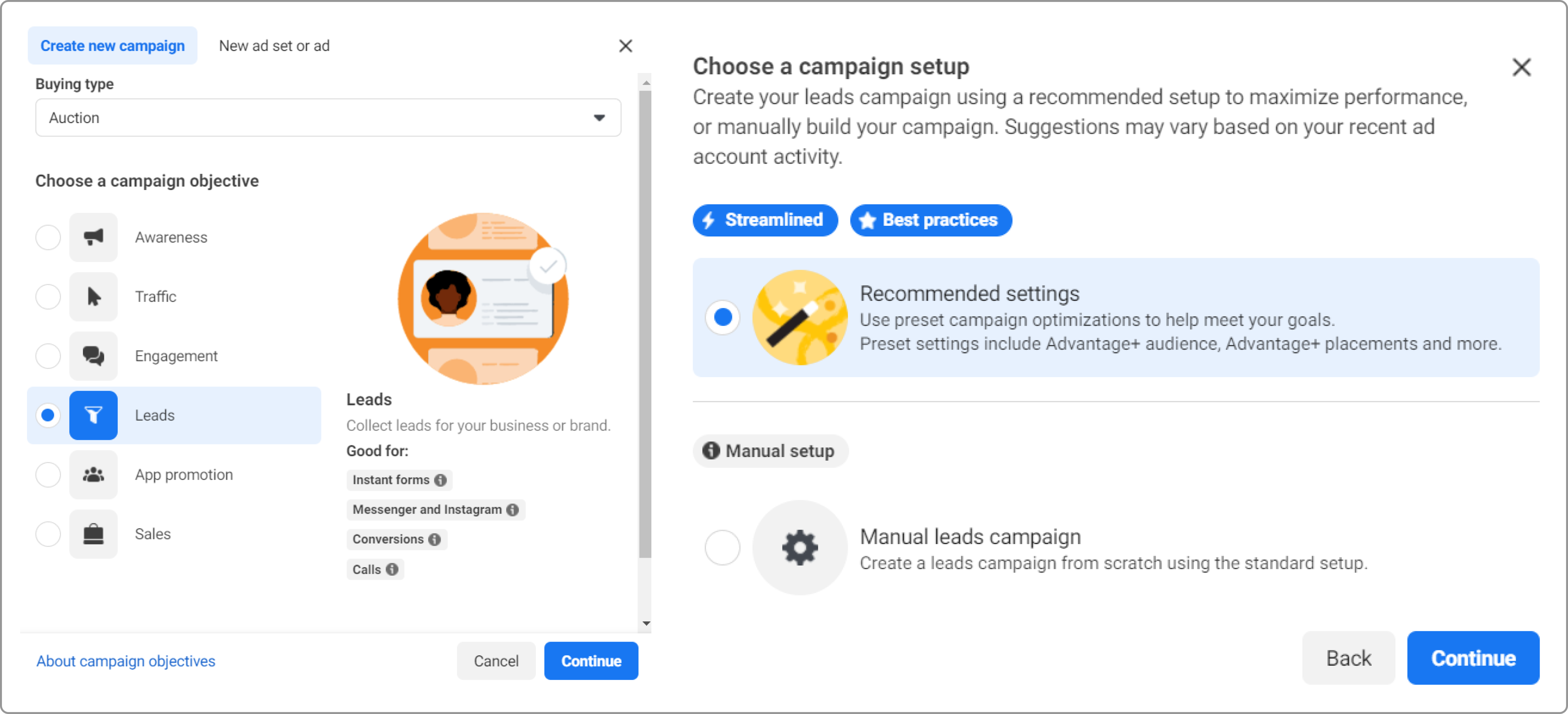
2. Select your target audience
At the Ad Set level of your campaign, you can choose who will see your ads based on various things like demographics, interests, behaviors, the devices they use, and so on.
Before you do this, conduct your audience research: figure out what your customers share in common, create distinct buyer personas for different audience segments, and check what types of ads and offers will appeal to each of them.
3. Set your budget and schedule
Define how much to spend daily on your ads and how long they’ll be running. Keep in mind that Facebook uses an auction system, so you need to choose a reasonable budget to compete with other advertisers. You can also let Facebook automatically adjust your budget to get the best results.
4. Upload your ad creatives
Picking the right ad creatives for your lead generation ads is important because they’re responsible for catching people's eyes and explaining what you're offering, making them either more or less likely to click on your ad and fill out your form.
Here are some tips that will help you get more leads with your Facebook ads:
- Focus on attention-grabbing visuals: use high-quality, relevant images that stand out (e.g. through bright colors). Short, engaging videos can be more effective than images, but you have to make sure they quickly convey your message;
- Write a clear and compelling copy: make the headline catchy and to the point, and keep the copy itself short and clear. Explain the value of your offer and why people should care and fill out your form;
- Test different creatives: it’s always a good idea to run several ad sets with different ad creatives to see what works better, so don’t settle for the first creative you come up with. Create multiple versions and test them to see which performs best;
- Keep your branding consistent: ensure your ad creatives match your brand’s look and feel and have your logo in visible places – you want people to recognize your business when they see your ads again;
- Follow Facebook's ad policies: make sure your creatives comply with Facebook’s ad policies to avoid any issues with ad approval. Also, avoid too much text in images and steer clear of misleading or sensational content. This is especially important for lead generation ads – people have to trust you enough to submit their information.
5. Create a lead generation form
Now, it’s time for the most important step: creating the lead generation form. Instead of sending people to a different website, Facebook allows you to create an instant form that pops up when users click on your ad.
But your form should be designed in a way that makes it easy for people to fill it out. Here’s what you’ll need to do to create your Facebook lead form:
- Choose the form type: you can pick a quick, easy-to-fill form for mobile users ("More Volume") or a more detailed form that includes a review step for people to confirm their data ("Higher Intent"). This will depend on your needs, so decide what you want to achieve with your lead forms first;
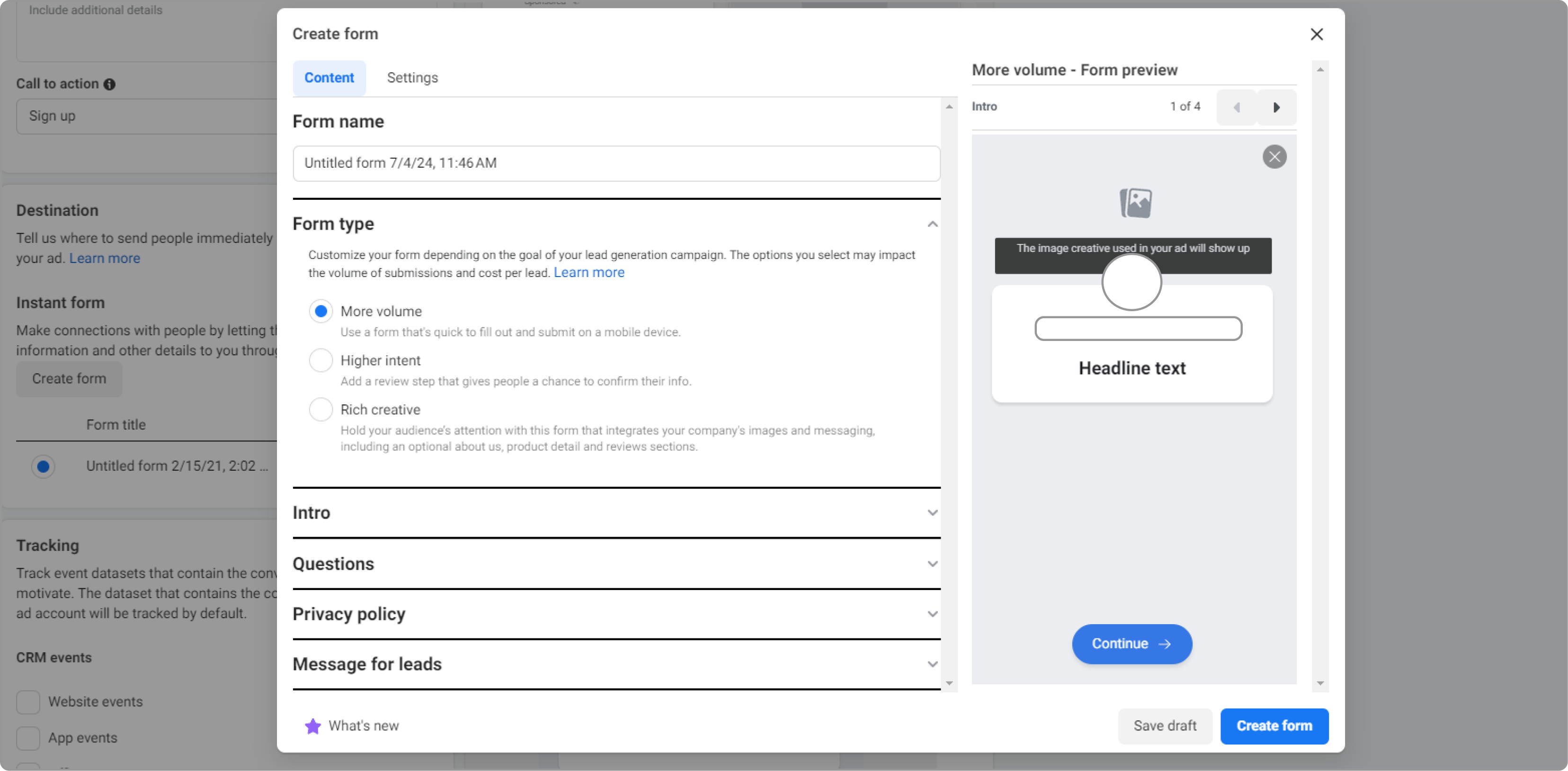
- Add an intro and greetings: pick a background image and write a friendly headline that explains why users should fill out the form and what they’ll get in return;
- Include relevant questions: ask for basic contact information and use simple questions with multiple-choice or short answers to get the scoop on your leads’ preferences, needs, shopping habits, and all other details that you need;
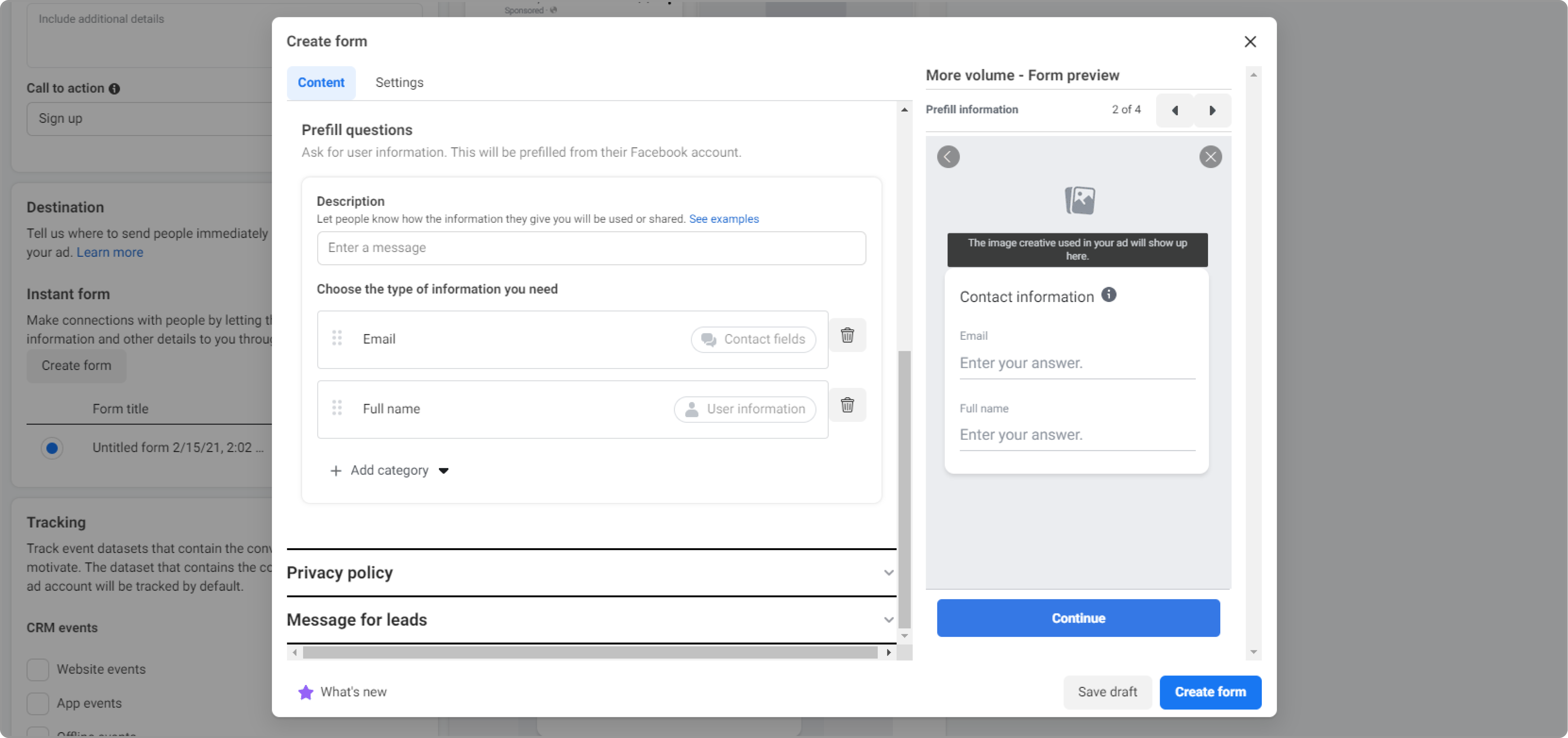
- Talk about privacy: add a link to your company’s privacy policy or any custom disclaimers to meet privacy rules in the region you’re located;
- Select a Call to Action (CTA): choose the action you want people to take after they submit the form and add the button that matches it, like “Go to website”, “View file” (if you’re offering gated content), etc;
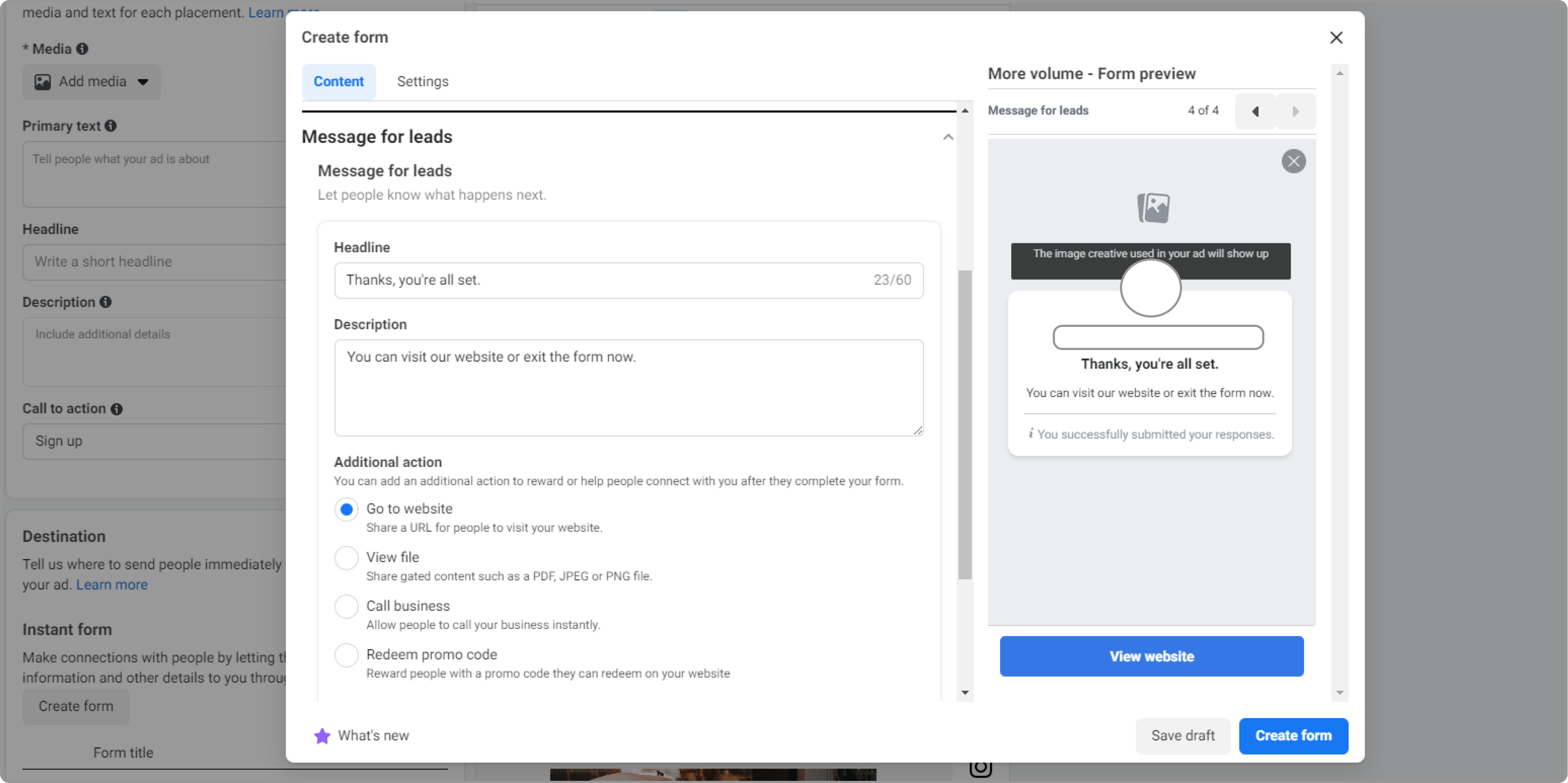
- Finish with a Thank You: write a thank you message that users will see after they submit the form.
Keep in mind that the shorter your forms are, the more likely people will be to complete them. However, it doesn’t mean you should compromise on the quality of the information you get: you need to find a balance between brevity and correct questions to get the most out of your lead generation forms.
6. Choose ad placements
When you're deciding where to put your Facebook lead ads, think about your audience first. Will they view your ads on their phones or desktop devices? Where are they more likely to notice your ad and not scroll past it?
Facebook can automatically decide where to show your ads based on how they perform, so it can be a good idea to start with automatic placements to see which ones work best. Once you know this, you can be more strategic in your choices and select specific placements.
Next, let’s talk about the best practices for creating Facebook Lead ads.
Facebook Lead ads: best practices
1. Make your ads engaging
First things first, your ad needs to grab attention. Even if you’re generating leads in a B2B sphere, your ad creatives should still follow the usual best practices for any ad. Use bright and interesting images or videos that make people stop scrolling, and tell them clearly why they should complete your form. If you give them a compelling reason, your form completion rates will be high, just as will the quality of the leads you get.
2. Offer valuable incentives
Besides using compelling language, you should also actually give people a good incentive to fill out your form. Offer something valuable based on their needs and preferences: a discount code, gift certificate, free sample or consultation, checklist or tutorial, etc.
Test different incentives to see what gets the best response.
3. Use pre-fill and multiple choice questions
To get more leads, you need to make things easy for people. Use prefill questions: the answers to them will be filled in based on people’s Facebook information. This will save them time and make your form less of a hassle. For the same reason, avoid asking too many short answer questions – it’s a quick way to lose people’s attention.
Also, add multiple choice questions to qualify your leads better. For example, you could ask how soon they’re looking to buy, how much they usually spend on products like yours, which of your products they’re interested in, what brands/businesses they usually prefer to choose, and so on.
This is a great opportunity to not just collect information for future lead nurturing, but also learn more about your audience.
4. Test different form lengths
If you want to know for sure how long your lead forms should be for optimal results, test different form lengths.
Create several forms with different numbers of questions, run A/B tests, and check which one gives you the best completion rates, cost per lead, and cost per conversion. This will help you figure out the perfect balance between getting enough information and not scaring people away with a too-long form.
5. Create a proper completion screen
After someone fills out your form, don’t just leave them hanging: have a completion screen that encourages them to take another action.
You can ask your leads to visit your Facebook Page, check out your website, or look at some related content. This will keep them engaged and help you build a stronger connection with your new leads.
6. Track ad performance
Finally, keep an eye on how your lead generation ads are doing. Use Facebook's tracking tools to monitor these important metrics:
- Leads: this is the basic indicator of how many leads you get;
- Cost per Lead (CPL): this metric calculates the cost of acquiring each lead to determine the efficiency of your campaigns;
- Conversion rates: this can help you measure the percentage of leads that take the desired action, such as signing up for a newsletter or making a purchase;
- Return on Ad Spend (ROAS): this helps you measure the overall profitability of your lead generation efforts;
- Form completion rates: this metric helps you understand how many people finish completing your forms till the end. The more effective your lead forms are, the higher this metric will be.
This will help you understand what’s working and what’s not, and then adjust your strategy based on these insights to get better results.
Recap
Using Facebook lead ads can make it a lot easier for you to gather customer information, and also helps people connect with your business.
By following the tips and best practices we’ve provided in this article, you can create lead generation campaigns that grab attention and turn interest into action. This way, you’ll consistently get high-quality leads, helping your business grow.
For more tips on running effective Facebook ads, check out our articles on Facebook ads for Ecommerce businesses, Facebook video ads, and Facebook retargeting ads.

